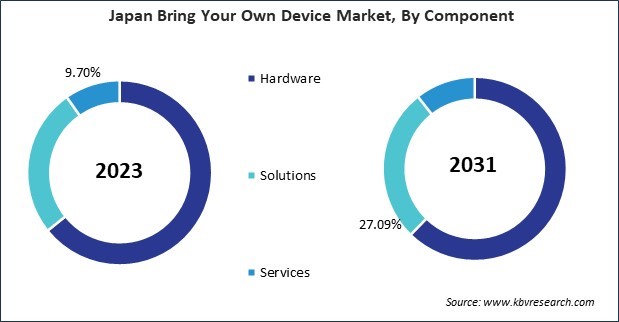The Asia Pacific Bring Your Own Device Market would witness market growth of 15.2% CAGR during the forecast period (2024-2031).
The China market dominated the Asia Pacific Bring Your Own Device Market by Country in 2023, and would continue to be a dominant market till 2031; thereby, achieving a market value of $50,838.6 million by 2031. The Japan market is registering a CAGR of 14.5% during (2024 - 2031). Additionally, The India market would showcase a CAGR of 15.9% during (2024 - 2031).

For employers, BYOD presents an opportunity to reduce costs and streamline operations. Employers can reduce the costs of purchasing, maintaining, as well as upgrading business-issued hardware by enabling employees to use their own devices. This allows the organization to save money. This cost-saving aspect of BYOD is particularly attractive to small and medium-sized enterprises (SMEs), which may have limited IT budgets. In addition to reducing hardware costs, BYOD can lower the demand for IT resources, as employees are responsible for maintaining their own devices.
Government regulations and industry standards will also be crucial in shaping the market's future. Organizations must guarantee that their BYOD policies adhere to pertinent laws and standards, particularly in regulated industries like healthcare and finance, as data privacy and security concerns continue to grow. Companies that operate in these industries must ensure that their BYOD policies are aligned with these regulations to avoid legal and financial repercussions.
In Australia, the growing demand for BYOD is largely driven by the country’s strong cultural emphasis on work-life balance and flexible work arrangements. This trend has continued post-pandemic, as businesses recognize the benefits of offering flexibility to employees. The increasing demand for BYOD in South Korea is driven by the country’s exceptionally high mobile penetration rate. According to the Korea Information Society Development Institute (KISDI), South Korea has one of the highest smartphone penetration rates globally, with over 95% of the population owning smartphones as of 2022. This widespread mobile adoption has made implementing BYOD policies easier for South Korean businesses, as employees are well-equipped with advanced personal devices. The South Korean government’s “Digital New Deal” initiative, which focuses on expanding digital infrastructure and promoting cloud computing, has further supported the integration of BYOD into workplaces. Thus, the region’s strong focus on technology innovation and government-backed digital initiatives drives sustained demand for BYOD solutions.
Free Valuable Insights: The Global Bring Your Own Device Market is Predict to reach USD 639.7 Billion by 2031, at a CAGR of 14.4%
Based on Organization Size, the market is segmented into Mid-to-Large-sized Businesses and Small Businesses. Based on Component, the market is segmented into Hardware (Smartphones, Tablets, and Laptops), Solutions (Mobile Device Management, Mobile Content Management, Mobile Application Management, Identity & Access Management, Endpoint Detection & Response, Mobile Expense Management, and Others), and Services (Professional Services {Deployment & Integration, Consulting, and Support & Maintenance} and Managed Services). Based on Industry, the market is segmented into IT, Energy & Utility, Retail, Healthcare, Automotive, and Others. Based on countries, the market is segmented into China, Japan, India, South Korea, Singapore, Australia, and Rest of Asia Pacific.
By Organization Size
By Component
By Industry
By Country
Our team of dedicated experts can provide you with attractive expansion opportunities for your business.

